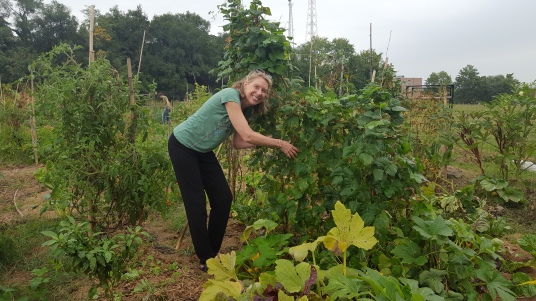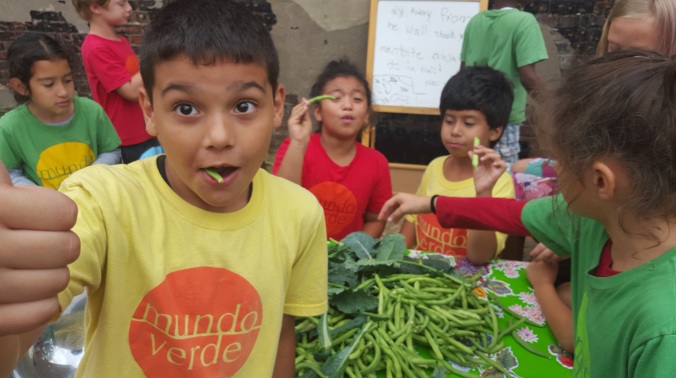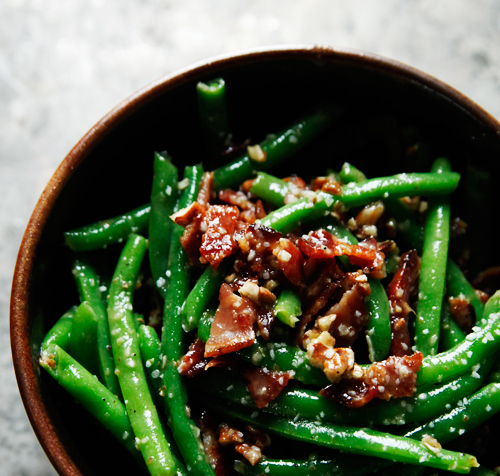Joe wasn’t kidding about the beans.
“I’m not seeing any flowers,” I whined in early August, gazing up at my pole bean plant that had already climbed eight feet up its trellis. No flowers meant no beans anytime soon. “Just wait,” said Joe (the garden educator for the Neighborhood Farm Initiative Kitchen Gardening Program), “soon you’ll have more than you can handle.” Pole beans race to the sky Jack-and-the-beanstalk-style. The climb upward lasts for weeks before they produce their bounty, unlike bush beans that stay reasonably grounded and produce decent harvests more promptly. But Joe was right; one week without warning, out popped the little buttery-yellow flowers, and two seconds later my trellis was dripping with beans. Beans that I would snap off and pop in my mouth with one hand, the other hand still working to harvest more beans beans beans. I could fill a gallon sized bag with all the green beans in one day’s harvest. Before I knew it, I was googling “bean and okra casserole” – something my New England-raised self never thought I would do, but that the realities of gardening in September drove me to.

My mother helping to harvest the pole beans in my plot at the Mamie D. Lee Community Garden. It takes a village!
Pole beans are the most fun vegetable to harvest; picking beans feels like a treasure hunt for the hanging, camouflaged fruit, making them a fun crop to grow in school gardens and engage students with! I have the fantastic job of Sustainability Coordinator and Cooking and Gardening teacher at Mundo Verde Bilingual Public Charter School, in Washington, DC. We have a wonderful school garden where students plant, tend to and harvest a variety of vegetables for tasting and using in cooking classes. I’ve found that when students pick it themselves, they are far more likely to want to stuff those vegetables in their mouths!

Second grade students at Mundo Verde Public Charter School and their bountiful school garden bean harvest!
Eventually, I realized that I was glad my pole beans bode their time. To explain, let’s talk about diversity. Diversity is a good thing everywhere: in human communities and in ecosystems. You want diversity in your pantry, on your plate, and in your 12 by 12 foot garden plot if you’re a community gardener like myself. By diversifying the crops you grow, you ensure that your garden is a robust workforce of colleagues with different strengths and weaknesses. Take Steve, the tomato, who excels at producing delicious fruit that everyone raves over in July and August. But he needs a lot of support from administration in the form of trellising, pruning, fertilizing and watering. Steve is also not so good at withstanding pests, diseases, bad weather…or really anything. (Seriously, why do beginning gardeners choose to start with tomato pots? They’re the most colicky plants.) Anna, the kale plant colleague, on the other hand is productive in the cooler weather months: May, June, October, November. She doesn’t need quite as much support from leadership as Steve does. But Anna really crumbles under the cabbage moth siege that inevitably comes in July. Really, Anna, every single year? Thank god for Petey the radish, that mild colleague who isn’t particularly popular, but he’s very reliable and can churn out a good product in a month’s time when everyone else is lost in the weeds. And we come to Beatrice the pole bean plant – that colleague you’ve had to let bide her time while she works on this lofty project with no sign of stopping. But whenever you start to think it was a mistake to include Beatrice on the team, you remember that she’s a nitrogen-fixer, which means she has the special talent of taking that all-important nutrient nitrogen out of the air and “fixing it” in the soil. Other plant colleagues gratefully absorb the added nitrogen through their roots to foster their own growth. Kind of like the colleague who’s always ready to cheerfully run to the Starbucks to get everyone a latté. And after all, Beatrice is not taking up that much space since she makes herself thin and tall, climbing up instead of spreading out like most other plant colleagues in the garden. Then finally, when you’ve almost forgotten about her and her projects, Beatrice gives you the full results of her workload in the format of 35 emails per day. But you’re glad to have the onslaught because the other colleagues have tapped out for the summer or are only starting to rev up again for the cool fall season.
At this point you’re probably saying OKAY, ENOUGH WITH THE RANDOM METAPHORS ABOUT BEANS. However before I go, let me share my favorite green bean recipe I discovered this season. Trust me, this one you have to try…because bacon. And maple syrup. ‘Nuff said.
Enjoy!
Green Beans with Bacon and Pecans, by Alice Currah in Savory Sweet Life.

- 3 tablespoons maple syrup
- 2 tablespoons olive oil
- 1 tablespoon red wine vinegar
- ½ teaspoon Dijon mustard
- 2 cloves garlic
- 1 lb. fresh green beans, trimmed
- 6 slices cooked bacon, crumbled
- ¼ cup chopped candied pecans
- salt and pepper
- Emulsify maple syrup, olive oil, red wine vinegar, Dijon mustard, and garlic in a food processor or blender, and set aside.
- Blanch green beans by boiling them for 3-5 minutes until crisp. Drain the beans immediately and transfer them to a large bowl of ice water. Wait three minutes and drain. Allow the green beans to air dry or by patting them with a paper towel.
- Toss the beans in the dressing and top them off with the crumbled bacon and pecans. Season lightly with salt and pepper.